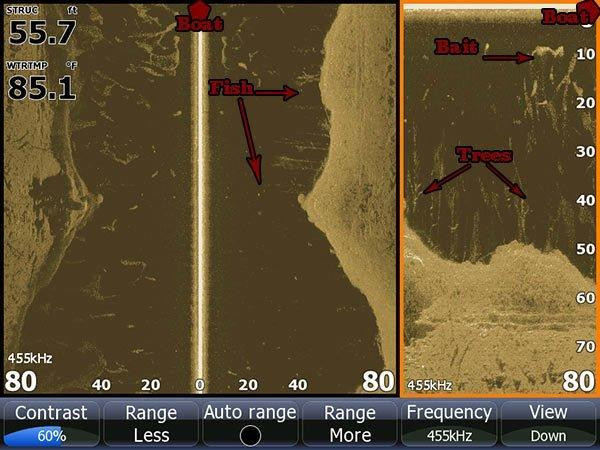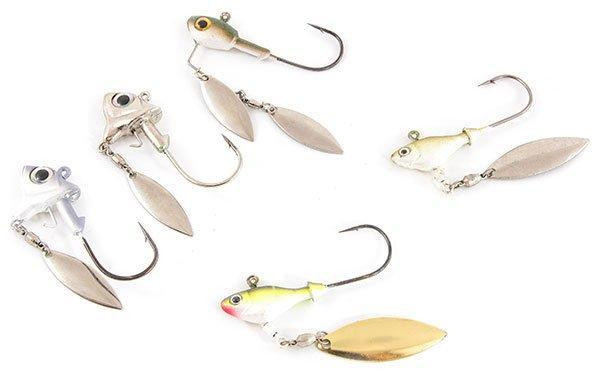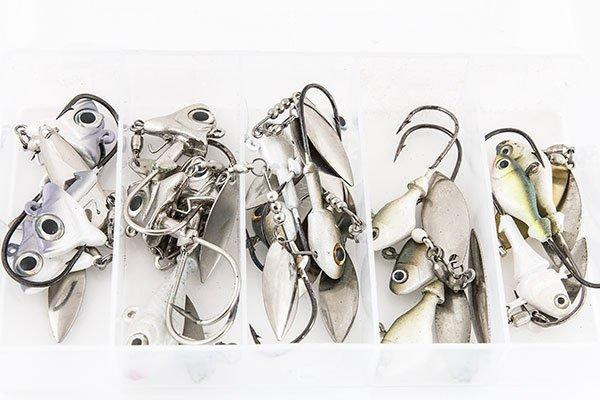Suspended bass can be a nightmare for many anglers. Whether they’re suspended due to a weather front or the time of year, they’re notoriously difficult to trick into biting. If you can learn to effectively fish underspins for bass, however, you’ll be able to catch more and bigger fish when other anglers fall short.
Fishing with underspins isn’t necessarily rocket science, but it can be a bit intimidating at times. These tips can shorten your learning curve and help you become an expert at this technique when targeting in-between bass.

Keep it above the bass
Whether bass are relating to the bottom, middle or top section of the water column, they’re always going to be looking upward. This natural instinct serves two primary purposes—it protects them from airborne predators while also increasing their feeding opportunities. When you’re targeting suspended bass with an underspin, it’s essential to keep it above the bass to maximize your chances of getting bit.
There are several vertical presentations that prove effective for suspended bass such as drop shotting and vertical spoon jigging, but if the fish aren’t at least 20 feet deep, they’re very wary of boat noise and shadows. This is where the underspin comes into play.
If you’re noticing fish suspended in 10 to 20 feet of water over a 30-foot bottom, underspins are a perfect choice. This technique gives you the ability to keep a safe distance from the bass to avoid any spooking and you’re also able to cover water more efficiently.
When looking for suitable underspin conditions, keep a close eye on your electronics. If you’re noticing a lot of fish activity close to the bottom, you may be better off using a more bottom-oriented presentation. When you notice suspended arches—or bass—underneath schools of shad—usually represented by big “balls” or “clouds” on your electronics—you’re in prime underspin territory.
Clear water is ideal
Although there are times when underspins can catch bass in stained water such as in schooling situations, this technique is most effective in clear water. As a general rule of thumb, the clearer the water, the better chance you have at a solid underspin bite.
Recommended gear:
- Rod: 7-foot, medium-heavy casting rod
- Reel: 6.3:1 casting reel
- Line: 10-pound fluorocarbon
Because stained and muddy water impairs bass’ vision, they’re often left to rely heavily upon their lateral line when feeding. This line acts as their ears and allows them to sense nearby vibrations, making it easier for them to track down an easy meal.
Fishing underspins is a very sight-oriented technique—they don’t emit much vibration for stained water bass to hone in on. They need to see an underspin in order to bite, which makes clear water conditions much more desirable.
Experiment with head sizes and trailer selection

Chances are, if you’ve looked into purchasing a few underspins to experiment with, the choices have been pretty overwhelming. The different head shapes and head weights are enough to make your head spin. There is good news, however—it doesn’t have to be complicated.
As with any bass fishing technique, you want to cater your underspin size and retrieve based on the level of aggression the bass are displaying. When they’re biting fast and furious, a faster retrieve is often more effective. Similarly, when the action is slow, a subtle, more deliberate presentation will often produce more bites.
Now let’s break that down a little more. The lighter head you use with an underspin, the slower you’re able to reel it and the longer you can keep it in the strike zone. If you’re targeting ultra-shallow suspended bass in depths ranging from five to 10 feet or very inactive, lethargic bass, you can get away with a much lighter head, such as a 3/16-ounce. This lightweight head will make a slow presentation much easier.
Don’t get too deep! Underspins can be troublesome when you get them around cover, so be sure to keep it above any standing timber or trees to minimize hang-ups. Clearwater bass can see a long way, so they’ll swim a long way to eat it.
Conversely, the heavier underspin you use, the faster you need to wind it. If the fish are actively chasing bait—often represented by long, diagonal lines streaking into bait clouds on your electronics— or suspending over deeper cover, you’ll be better off with a heavier, 3/8-ounce or 1/2-ounce head.
Your trailer selection will also vary based on the same two factors—depth and speed of retrieve. A paddle tail swimbait is going to sink a bit slower due to its increased bulk and water displacement, allowing for a slower retrieve speed, which can be especially effective in shallower depths and around inactive bass. A more streamline trailer, such as a soft, fork-tail soft plastic jerkbait will sink faster and allow for faster retrieve speeds, making it most effective around deeper or aggressive bass.
Make the bass react
If you spend an entire day steadily winding an underspin, you’ll probably catch fish. The flash of the blades and the trailer’s subtle movement is enough to result in a few bites, but we’re bass fishermen—we always want to catch more and bigger bass, right?
To get more bites with an underspin, be sure to implement periodic pauses and small jerks throughout your retrieve. Clearwater bass can be extremely finicky and you’ll notice a lot of them slowly lumbering behind your underspin—they want to eat it, but something doesn’t seem quite right. If the bass aren’t committing, these jerks and pauses can appeal to their innate predatory instincts and cause them to override any suspicions they may have.
It’s also important to consider the natural behavior of shad. If you’ve ever seen big balls of shallow shad surrounding your boat or the bank, you’ll notice they don’t necessarily swim in straight lines. Every second or two, one will kick to the side, causing the rest of the school to flare and show their sides. When you incorporate these small jerks and pauses, the blade or blades of your underspin will also flare, imitating a nervous or fleeing shad. If a bass thinks something is getting away, they’re going to attack it more times than not.
Set the hook correctly
When any bass angler feels a bite on the other end of their line, their first reaction is to jerk or pull back. Similar to topwater fishing, a large hookset is not necessary when fishing an underspin. In fact, an aggressive hookset will cause you to lose the majority of your underspin bass.
Don’t rule out schoolers: Underspins can be effective when targeting shallow bass gorging themselves on bait. They offer a much different profile than traditional hard baits, which can result in fast action.
Detecting bites on an underspin is going to take a little practice. Again, it’s not very difficult, but it’s very different when compared to more popular bass fishing techniques. When you get your first bite, it’s going to be a sudden “thump”, almost like a swimbait bait. When you feel this thump, do not pull back—bass have a tendency to miss an underspin initially. Just keep reeling steadily and you’ll feel a few subsequent thumps and your rod will slowly begin to load. Again, maintain your steady retrieve and when you notice a nice, solid bend in your rod, simply lean into the fish while reeling and keep good tension. No jerking, pulling, jumping or pumping required—a slow and steady hookset will drastically increase your catch ratio.
Super glue is your friend

Throughout this piece, we’ve continuously referenced the attentiveness of clear water bass. They can see very well, resulting in frequent short strikes throughout the fishing day. Not only are these short strikes disheartening at times, but they also cost money, believe it or not.
Every time a bass nips at or short strikes your underspin, the trailer takes the brunt of the shock. Before you know it, the bottom of your boat is littered with chewed-up soft plastics. Over time, this can get pretty darn pricey, but that’s where super glue saves the day.
When you’re threading a trailer, whether it’s a swimbait or soft jerkbait, onto your underspin, place a few drops of super glue onto the front of the trailer where it meets the head of the lure. This increases the rig’s structural integrity, allowing you to fish hours—and sometimes a whole day—with one soft plastic trailer.
Whether you’re reading this in the winter, spring, fall or summer, an underspin is an outstanding way to catch suspended bass in clear water. If you practice recognizing the strike zone, choosing the right head size and trailer combination, making the bass react and a proper hookset, you’ll soon perfect the remedy for stubborn, in-between bass.












